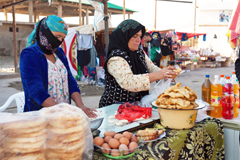Household Survey conducted in Tajikistan with the World Bank Reveals Data on Remittances by Migrants
2018.06.20
Tajikistan is highly dependent on income from migrant workers in other countries (in Russia in particular) and in some years the remittances from migrant workers exceed 40% of the GDP. How do households with migrants work and live? Further, how are they affected by changes in external economic conditions, and how do they cope with them? Understanding the economic behavior of those households is vital for designing effective development projects in countries and regions dependent on migrant workers.

Women working at a market of Khamadoni in south part of Tajikistan (Photo:JICA/Shinichi Kuno)
As part of the "Study on Remittances and Household Finances in the Philippines and Tajikistan" project, the JICA Research Institute (JICA-RI) is participating in the "Listening to Tajikistan (L2TJK)" study implemented by the World Bank. L2TJK continuously tracks the status of 800 households distributed throughout Tajikistan using computer-assisted telephone interviews (CATI). The study was launched in June 2015, and has since then conducted telephone interviews at a rate of about once per month. Because the telephone interview does not require a trip to the interviewees' homes, the high-frequency panel survey can be conducted inexpensively, and is suited to dynamically grasp household circumstances.
JICA-RI has participated in the study since September 2017. In addition to the matters already investigated by the World Bank, JICA-RI Research Fellows Eiji Yamada and Enerelt Murakami, and Visiting Scholar Akira Murata proposed additional survey items related to migrants, the status of remittances and the lifestyles of the households, and collaboration has begun. Bulletins reporting the latest survey data have been posted on the World Bank's website below.
The data trends for matters related to migrants and those related to the use of means of transportation are presented this time. PDF files of the reports are available at the following links.
For example, the bulletin on matters related to migrants compares the status of employment in households with migrants and in those without. The employment rate in households with migrants was about 10% lower throughout the period, implying that households with migrants work less in Tajikistan compared to those without migrants. (see Graph: Household Head Currently Working). Further, despite having a higher level of income (see Graph: Average Real PC Income by HHS with and without Migrants), households with migrants had low levels of savings (see Graph: Amount Saved), suggesting that they have a higher propensity to consume.
JICA-RI will continue working with the World Bank in this study, and strive to communicate its findings to academia and the front lines of development.

事業事前評価表(地球規模課題対応国際科学技術協力(SATREPS)).国際協力機構 地球環境部 . 防災第一チーム. 1.案件名.国 名: フィリピン共和国.

事業事前評価表(地球規模課題対応国際科学技術協力(SATREPS)).国際協力機構 地球環境部 . 防災第一チーム. 1.案件名.国 名: フィリピン共和国.

事業事前評価表(地球規模課題対応国際科学技術協力(SATREPS)).国際協力機構 地球環境部 . 防災第一チーム. 1.案件名.国 名: フィリピン共和国.

事業事前評価表(地球規模課題対応国際科学技術協力(SATREPS)).国際協力機構 地球環境部 . 防災第一チーム. 1.案件名.国 名: フィリピン共和国.

事業事前評価表(地球規模課題対応国際科学技術協力(SATREPS)).国際協力機構 地球環境部 . 防災第一チーム. 1.案件名.国 名: フィリピン共和国.
scroll